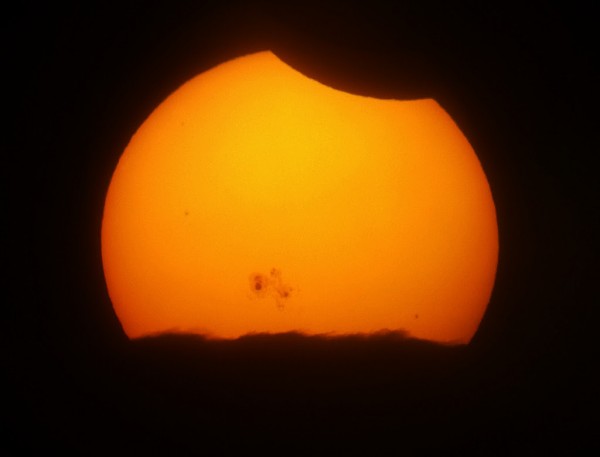Above: Partial solar eclipse on October 23, 2014, via Mikael Linder
The new moon supermoon causes a partial solar eclipse on August 11, 2018. It’s visible in the Arctic, far-northeastern Canada, Greenland, Iceland, Scandinavia, and much of Asia (north and east). The animations below show where the eclipse is taking place.

P1: 8:02 UT: The Moon's penumbral shadow has touched down off the eastern coast of Canada, marking the start of today's partial solar eclipse: https://t.co/9eYxoi7y3Q pic.twitter.com/vYkk5UOFuO
— Dave Dickinson ???? (@Astroguyz) August 11, 2018
This same new moon, by the way – which crosses the sky with the sun during the day – is leaving night skies dark this weekend for the annual Perseid meteor shower. Click here for Perseid prospects in 2018. With no moon up after dark, the Perseids should be awesome this year! Earth’s most northerly regions – within and near the Arctic Circle – are drenched in daylight at this time of year. These parts of Earth are in a good position to watch the solar eclipse, but not the Perseids.
On a worldwide scale, the August 11 partial eclipse lasts about 3 1/2 hours, starting at sunrise in northeastern North America and ending at sunset along the Asian Pacific Coast. If you’re in a position to witness this eclipse (see map below), be sure to use proper eye protection.

We give the local times of the eclipse for several localities below. If your locality is not listed, the local eclipse times for hundreds of cities are available at EclipseWise or TimeandDate.
August 11, 2018, partial solar eclipse
Alert, Nunavut, Canada
Eclipse begins: 4:24 a.m. local time
Maximum eclipse: 5:12 a.m. local time
Eclipse ends: 6:00 a.m. local time
Eclipse obscuration: 48.2% of the solar disk
Helsinki, Finland
Eclipse begins: 11:51 a.m. local time
Maximum eclipse: 12:18 p.m. local time
Eclipse ends: 12:45 p.m. local time
Eclipse obscuration: 2.7% of the solar disk
Beijing, China
Eclipse begins: 6:13 p.m. local time
Maximum eclipse: 6:51 p.m. local time
Eclipse ends: 7:14 p.m. local time
Eclipse obscuration: 23.0% of the solar disk
Sources: EclipseWise and TimeandDate.
Click at any chosen spot on this cool interactive Google eclipse map for eclipse times. However, you must convert Universal Time to local time. Here’s how.
Three eclipses in one lunar month
The August 11, 2018, partial solar eclipse is the third of three eclipses in one lunar month – the period of time between successive new moons (approximately 29.5 days):
Partial solar eclipse: July 13, 2018
Total lunar eclipse: July 27, 2018
Partial solar eclipse: August 11, 2018
A solar eclipse, when it happens, always occurs within one fortnight (approximately two weeks) of a lunar eclipse. An eclipse season – which regularly recurs several days shy of six calendar months – more often than not presents only two eclipses (one solar and one lunar). However, given certain circumstances, it’s actually possible for an eclipse season to showcase three eclipses – either two solar and one lunar, or two lunar and one solar.
If the full moon aligns especially closely with the central part of the Earth’s dark shadow, as it did on July 27, 2018, the result is an especially long-lasting total lunar eclipse. In this scenario, the total lunar eclipse is flanked one fortnight before and after by a partial solar eclipse.
Read more: Century’s longest lunar eclipse July 27
It’s no accident that one of these two partial solar eclipses (July 13, 2018) took place in the southern part of the globe, whereas the other (August 11, 2018) reigns in the northern regions. That’s always the case whenever two partial solar eclipses flank a central total lunar eclipse, such as the one on July 27, 2018.
Read more: Middle of eclipse season on July 28
The last time a total lunar eclipse and two partial solar eclipses happened in one lunar month was in 2011 and the next time will be 2029:
Partial solar eclipse: June 1, 2011
Total lunar eclipse: June 15, 2011
Partial solar eclipse: July 1, 2011Partial solar eclipse: June 12, 2029
Total lunar eclipse: June 26, 2029
Partial solar eclipse: July 11, 2029
One Saros period of 223 lunar months (18.03 years) separates the eclipses of 2011 and 2029. But it’s 88 lunar months (7.115 years) that separate the eclipses of 2011 and 2018, whereas it’s 135 lunar months (10.915 years) that separate the eclipses of 2018 and 2029. The former eclipse cycle of 88 lunar months is known as the Tzolkinex, and the latter eclipse cycle of 135 lunar months is called the Tritos. Added together, the Tzolkinex and Tritos equal one Saros period.
The total lunar eclipse on July 27, 2018, followed the partial solar eclipse on July 13, 2018, and preceded the partial solar eclipse of August 11, 2018. But that’s not all. The smallest full moon of the year on July 27, 2018, came one fortnight (two weeks) after the new moon supermoon of July 13, 2018, and before the new moon supermoon on August 11, 2018.
Read more: Friday the 13th supermoon solar eclipse
Bottom line: Those on the northernmost end of Earth will see a partial eclipse of the sun on August 11, 2018. A supermoon at the new phase will cause this eclipse.












